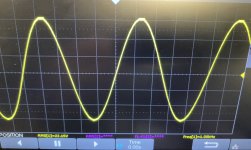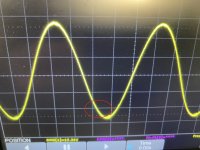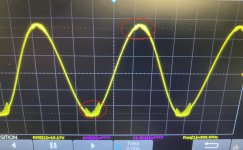Without put them in circuit and measure result, of course!
I was wondering about how to check authenticity of the chip. I got a numbers of chip when it was scarce from various dealers. Just want to check them before putting them in my next project. Apart from buying from reputable dealers and obvious dodgy looking chips, I have seen very convincing laser-engraving counterfeit chips/parts that often work but might not up to spec of authentic chip.
As a result, I thought that maybe we can measure resistance or using diode function or other measurement from basic DMM or oscilloscope to measure them? For instance, TI publishes equivalent schematic and shown BJC power transistors between output (pin 3) and V+ (pin 1, 5) and V- (pin 4), so I should expect measuring between base, emitter and .45 ohm resistors between pin 3, 1 and 3, 4? Additionally, input transistors could be measure at pin 9, 10 and V+ (base and collector)? They should have similar result?
Additionally, measuring resistance between power supply pins and ground (pin 7) should yield reasonable results, but what are ranges of reasonable result should I expecting?
Thanks for your comment.
AP
I was wondering about how to check authenticity of the chip. I got a numbers of chip when it was scarce from various dealers. Just want to check them before putting them in my next project. Apart from buying from reputable dealers and obvious dodgy looking chips, I have seen very convincing laser-engraving counterfeit chips/parts that often work but might not up to spec of authentic chip.
As a result, I thought that maybe we can measure resistance or using diode function or other measurement from basic DMM or oscilloscope to measure them? For instance, TI publishes equivalent schematic and shown BJC power transistors between output (pin 3) and V+ (pin 1, 5) and V- (pin 4), so I should expect measuring between base, emitter and .45 ohm resistors between pin 3, 1 and 3, 4? Additionally, input transistors could be measure at pin 9, 10 and V+ (base and collector)? They should have similar result?
Additionally, measuring resistance between power supply pins and ground (pin 7) should yield reasonable results, but what are ranges of reasonable result should I expecting?
Thanks for your comment.
AP
I don't think its viable as a test method tbh and I suspect you would get different readings from using different DVM's to test the same chip due to differences in test currents and voltages. Equivalent circuits in data sheets often bear little resemblance to the actual complete functional chip, they are really just easy to assimilate representations of the basic structure.
A fake device could contain a genuine die that didn't pass the final test. In that case you wouldn't be able to measure any difference unless you ran the IC through the same test program as used by TI and found where it failed.
If you bought them all from the same source you could sacrifice one of them by dissolving the plastic in hot nitric acid. Then inspect the die markings under a microscope. I'm told that a butane torch can do the job too.
If the device contains a different die, you might be able to set up a test that exposes this. I would probably set up a test where the LM3886 is run with a gain of 10x (20 dB) and then drive it to clipping. Look at the clipping behaviour and compare against a known good sample. You could also measure things like slew rate, bandwidth, and output current.
Tom
If you bought them all from the same source you could sacrifice one of them by dissolving the plastic in hot nitric acid. Then inspect the die markings under a microscope. I'm told that a butane torch can do the job too.
If the device contains a different die, you might be able to set up a test that exposes this. I would probably set up a test where the LM3886 is run with a gain of 10x (20 dB) and then drive it to clipping. Look at the clipping behaviour and compare against a known good sample. You could also measure things like slew rate, bandwidth, and output current.
Tom
Yes, I think you can verify with enough certainty if a LM3886 is genuine or not.
I recently was told about this possibility and already tested different ICs from different market places.
I recently was told about this possibility and already tested different ICs from different market places.
Sure, here is how I did it, but first some introduction.
1. Every IC has its own OLG (open loop gain) and phase vs frequency response. That response is quite specific, like a fingerprint.
2. Counterfeits may have two origins - scrapped die or complete fake ones. Usually both don't have the same OLG and phase vs frequency response.
3. It is very difficult to precisely measure OLG and phase vs. frequency response.
4. Including the DUT (in our case LM3886) in a sensitive circuit (for which to function properly the proper OLG and phase vs frequency response is required) might help clearly to distinguish genuine from counterfeit part.
5. Concerning LM3886, making the IC chip a part of a properly functioning composite amplifier (properly chosen zeros and poles, etc.) can certainly serve as a point of reference to distinguish genuine from counterfeit IC in means of OLG and phase vs frequency, slew rate, behavior near clipping (max power and overheating), etc.
So I got such a composite amp a couple of months ago (actually just the PCB and the circuit description) and tested several different LM3886s from different sources. The only things you need are a good signal generator, oscilloscope and dummy load resistor.
I had no idea that I was going to discuss this and didn't take any pictures to illustrate the differences between fakes and genuine parts, but they are pretty obvious. Maybe later I'll draw some sketches to illustrate what I mean. The test itself takes a couple of minutes or less but soldering and unsoldering the IC is giving me really hard time.
1. Every IC has its own OLG (open loop gain) and phase vs frequency response. That response is quite specific, like a fingerprint.
2. Counterfeits may have two origins - scrapped die or complete fake ones. Usually both don't have the same OLG and phase vs frequency response.
3. It is very difficult to precisely measure OLG and phase vs. frequency response.
4. Including the DUT (in our case LM3886) in a sensitive circuit (for which to function properly the proper OLG and phase vs frequency response is required) might help clearly to distinguish genuine from counterfeit part.
5. Concerning LM3886, making the IC chip a part of a properly functioning composite amplifier (properly chosen zeros and poles, etc.) can certainly serve as a point of reference to distinguish genuine from counterfeit IC in means of OLG and phase vs frequency, slew rate, behavior near clipping (max power and overheating), etc.
So I got such a composite amp a couple of months ago (actually just the PCB and the circuit description) and tested several different LM3886s from different sources. The only things you need are a good signal generator, oscilloscope and dummy load resistor.
I had no idea that I was going to discuss this and didn't take any pictures to illustrate the differences between fakes and genuine parts, but they are pretty obvious. Maybe later I'll draw some sketches to illustrate what I mean. The test itself takes a couple of minutes or less but soldering and unsoldering the IC is giving me really hard time.
So here are a few pictures that illustrate what was said in the previous post.
Picture one - Genuine LM3886, clipping starts around 22.00V rms, very clean output signal.
Picture two - Counterfeit 1, not so bad. Above 19.00V rms starts to oscillate and clipping occurs around 21.00V rms.
Picture three - Counterfeit 2. Things become ugly. Severe oscillation around 19.00V rms and much earlier clipping.
There were even worse counterfeits where the oscillation starts immediately at any output voltage.
Some counterfeits were almost identical to the genuine IC but started to oscillate when the temperature of the chip rises.
So wrapping up: Yes, there is a very efficient electrical way to discriminate genuine from counterfeit LM3886 IC chips.
Picture one - Genuine LM3886, clipping starts around 22.00V rms, very clean output signal.
Picture two - Counterfeit 1, not so bad. Above 19.00V rms starts to oscillate and clipping occurs around 21.00V rms.
Picture three - Counterfeit 2. Things become ugly. Severe oscillation around 19.00V rms and much earlier clipping.
There were even worse counterfeits where the oscillation starts immediately at any output voltage.
Some counterfeits were almost identical to the genuine IC but started to oscillate when the temperature of the chip rises.
So wrapping up: Yes, there is a very efficient electrical way to discriminate genuine from counterfeit LM3886 IC chips.
Attachments
A scrapped LM3886 die is extremely likely to have the same AVOL curve as a genuine LM3886 die. It all depends on why the die was scrapped in the first place.2. Counterfeits may have two origins - scrapped die or complete fake ones. Usually both don't have the same OLG and phase vs frequency response.
Not really. Configure the amp as an inverting amp. Measure the differential voltage between the inputs vs frequency. That's the inverse of the loop gain. Then just invert the graph.3. It is very difficult to precisely measure OLG and phase vs. frequency response.
Tom
Yeah, it looks easy said in this way but when you try to do it in the real world is more complicated. On top of that it takes a lot of time if you don't have expensive equipment. Another difficulty is when the signals get really low when the OPG nears 0dB.Not really. Configure the amp as an inverting amp. Measure the differential voltage between the inputs vs frequency. That's the inverse of the loop gain. Then just invert the graph.
Anyway, it is possible to measure the OLG in this way.
No. Not really. I did it many times in the real world when I designed opamps for National Semiconductor.Yeah, it looks easy said in this way but when you try to do it in the real world is more complicated.
Tom
Ok, you win!I did it many times in the real world when I designed opamps for National Semiconductor.
Let's summarize it in this way - It is easy to do it when you work for National Semiconductor.
It's easy to do when you have the skill and the equipment. Then again, a vector network analyzer is not that expensive these days. And you could probably get enough information with just an o'scope and a signal generator.
Personally, I would probably look at the clipping behaviour like you did. The LM3886 has a pretty unique signature there. That wouldn't weed out a test reject that was swept from the TI factory floor, but it would likely eliminate the obvious fakes.
Tom
Personally, I would probably look at the clipping behaviour like you did. The LM3886 has a pretty unique signature there. That wouldn't weed out a test reject that was swept from the TI factory floor, but it would likely eliminate the obvious fakes.
Tom
I would suggest that after verifying the external construction and marking are believable, that further investigation is only semi-useful. I've seen cases where a power IC has had a plain ole op-amp substituted inside, so trying to drive a normal 8-ohm load at power would separate out a number of bad units. Also, the LM3886 has a unique mute function which is not likely to be mirrored in a counterfeit.
I'd be more inclined to just toss any questionable units and buy from a reputable distributor rather than spend valuable time and effort to try to validate questionable material. The price from TI.com or Digi-Key, etc., is not that high.
I'd be more inclined to just toss any questionable units and buy from a reputable distributor rather than spend valuable time and effort to try to validate questionable material. The price from TI.com or Digi-Key, etc., is not that high.
Now there's an idea.I'd be more inclined to just toss any questionable units and buy from a reputable distributor rather than spend valuable time and effort to try to validate questionable material. The price from TI.com or Digi-Key, etc., is not that high.
TI will sell to anybody with a credit card. They charge a very reasonable flat fee for shipping.
Tom
If you can distinguish just examining the counterfeits with a magnifying glass or microscope from the genuine part, then most probably you're looking at a counterfeit of the counterfeit. Counterfeits are a huge industry and sometimes it is state sponsored.I would suggest that after verifying the external construction and marking are believable, that further investigation is only semi-useful.
In a non-critical implementation a good counterfeit may perform just fine - maybe higher distortions and noise, worse thermal performance, less output power. But who cares if it goes into a TV set?
When it comes to more complex implementations like composite amplifiers, counterfeits can't cope with the task. In implementations like that composite on eBay or Modulus they just don't fit.
This is just a theoretical discussion as purchasing directly from TI or well recognized distributors is all that you need, like it was already said in the previous post.
To check some cheap ones I bought on Amazon, I feed them +-30 Volt, drove them into clipping and shorted the outputs a few times. The real ones should stand this test.
May sound cruel, but I wanted to be sure they don't blow on the first occasion and kill the speaker that is 40 times as expensive. Also, fakes have no value anyway, so better burn them.
The clean clipping behavior may be the cause one you can drive them much louder than expected from such a relative low Watt amp, without them sounding as ugly as a typical overdriven transistor amp. The real LM3886 are really exceptionable chips.
May sound cruel, but I wanted to be sure they don't blow on the first occasion and kill the speaker that is 40 times as expensive. Also, fakes have no value anyway, so better burn them.
The clean clipping behavior may be the cause one you can drive them much louder than expected from such a relative low Watt amp, without them sounding as ugly as a typical overdriven transistor amp. The real LM3886 are really exceptionable chips.
I think you mean 'exceptional'. If so, I agree with you. It's a very rugged and reliable chip. Follow the recommendations in the Applications Section of the data sheet and it will take good care of you.The real LM3886 are really exceptionable chips.
Tom
Gonkar, on a somewhat unique package like the LM3886's TO-220-on-steroids, visual inspection can get you pretty far. There have been several threads on this forum with pictures of counterfeits (and legit units). Invariably there's something different about the package, leads, quality/finish of the mold compound, marking, date code, etc., that give the counterfeits away. I've seen this multiple times both on this forum and in my day job were I have sometimes had to investigate counterfeit ICs. But as I said, given we're no longer in the time of supply chain issues I wouldn't spend a lot of time trying to tell a fake device as new ones can be readily purchased for less than the price of a cup of coffee.
A fake device could contain a genuine die that didn't pass the final test.
I think that's the overwhelming scenario that leads to the "fake" label. My friends tell me every factory in China has a front door and a back door. What comes out through the front door bears the label of the party paying for the manufacturing. What comes out through the back door is something that didn't clear the bar, but still works.
Thanks everyone. I ended up test them in circuit anyway. Desoldering chip is a pain without specialized tools.
These are counterfeit chips, but it sorta works on the same circuit. However, they don't meet spec. Frequency response is not ok and they can't run 4 ohm.
BTW, torch doesn't work...

These are counterfeit chips, but it sorta works on the same circuit. However, they don't meet spec. Frequency response is not ok and they can't run 4 ohm.
BTW, torch doesn't work...
Last edited:
- Home
- Amplifiers
- Chip Amps
- Is there a way to electrically verify good and genuine chip? LM3886


